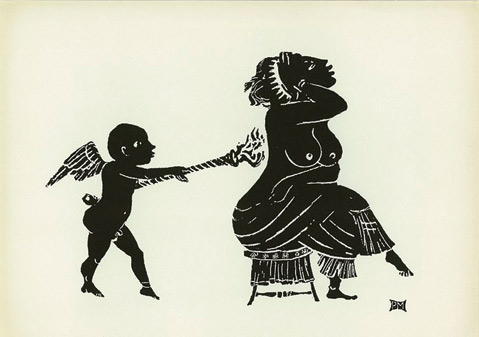The Art of Peter Meller
UCSB Professor of Art History Was Prolific Artist as Well

UCSB Professor of Art History emeritus Peter Meller led a double life, one side of which has only begun to be fully revealed since his death at age 85 in 2008. Thanks to a pair of new exhibitions (at the UCSB Art, Design & Architecture Museum and the Jane Deering Gallery) and a publication (The Zodiac of Wit: Peter Meller and the Graphic Imagination by Robert Williams), those outside of Meller’s immediate circle are now in a position to know that, in addition to being a highly respected scholar in the field of Italian Renaissance art, Meller was also an interesting, innovative, and prolific graphic artist. Using such basic office supplies as rubber ink stamps, Wite-Out correction fluid, and the Xerox photocopier, Meller created a comprehensive oeuvre that includes portraits, landscapes, and tableaux populated by a mix of humans, animals, and mythological figures.
With its roots in his thorough knowledge of classical Latin and Greek, its powerful trunk in his lifelong study of Renaissance masters like Leonardo da Vinci, and its fruit in the countless ironic images Meller created while living in Isla Vista, Santa Barbara, and Solvang, the green tree of Peter Meller’s art is without question one of the most valuable and exotic specimens in the garden of our civic culture. Through his self-awareness as a Hungarian scholar of Italian art living in Southern California, Meller invented a world that is at once instantly recognizable and persistently strange. The fact that the vast majority of Meller’s art has, up until now, rarely if ever been seen by the public only adds to the allure of these vivid images.
In order to understand Meller’s contribution to the art of graphic design, it is useful to look more closely at some of the processes he used. Take, for example, the two parts of his portrait “Seated Girl in Classical Dress.” In the first image we see Meller’s characteristic skill in rendering specific poses and moods with a minimum of marks and a high degree of contrast. With her hand to her chin, her attentive gaze, and her telltale notebook, this could easily be a sketch of a student in class but done with the eye for detail, pattern, and contrast of a Renaissance master. This ink drawing is what Meller took to the UPS store where he paid by coin to use an early version of the photocopier. Once he had the image photocopied, Meller altered it at home with tools like oil crayons and (Meller’s secret weapon) a small bottle of white correction fluid. Returning to the copier with his altered image, Meller was able to give his initial sketches the depth, complexity, and tone he sought.
Although the photocopier may be Meller’s most characteristic printing device, he also produced an extraordinary array of original designs using his own hand-carved rubber stamps. These gave rise to many intricate images based on the aggregation, inversion, and reversal of their patterns, as in the landscape “Three Trees.”
Elsewhere, Meller brought forth such mythological figures as satyrs, cupids, and centaurs, imbuing them with a rueful sympathy for the earthly limitations imposed on slumming gods and goddesses. In this vein we see such images as Mary Magdalene before a mirror, admiring the fit of her newly acquired halo, or wise Minerva, her lips pursed as she learns something from an intelligent pig. The broader implications of this marvelous discovery will only be known in time, but for now it is clear that Meller’s art has much to offer audiences today, and the UCSB AD&A Museum is to be congratulated for making his work widely available for the first time.



